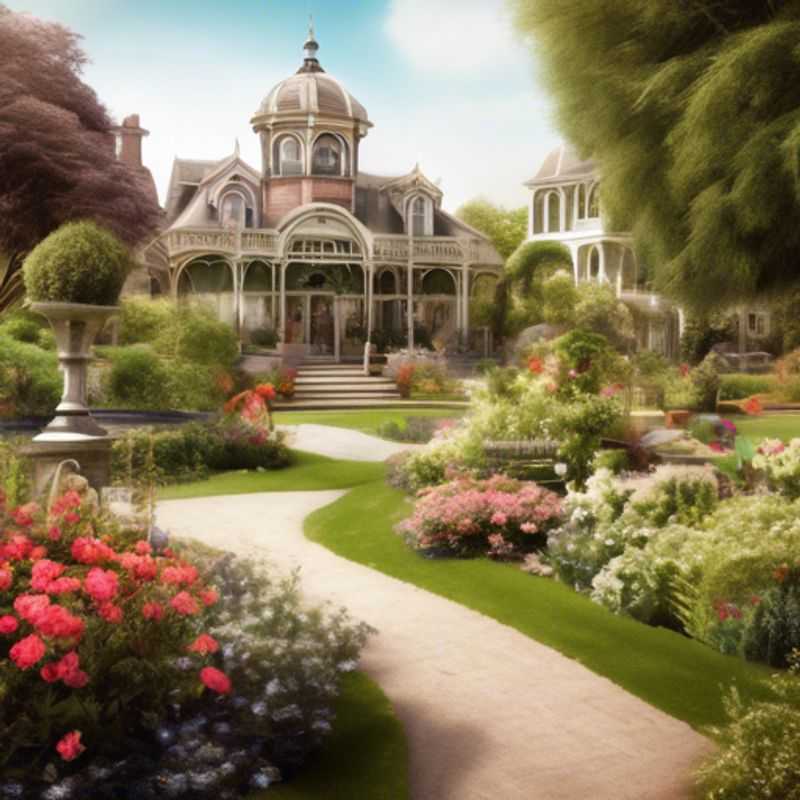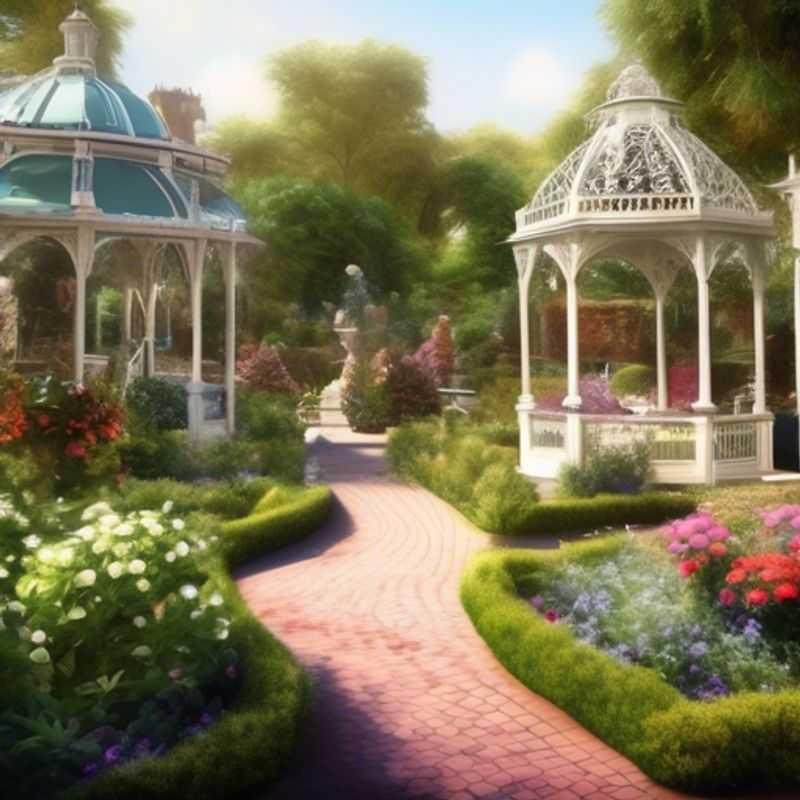Essential Insights Before Embarking on a Victorian Garden Creation

Unveiling the Victorian Garden: 7 Essential Considerations Before You Buy
Ah, the Victorian garden, a timeless testament to beauty and horticultural mastery. But before you embark on this charming journey, there are some vital things to consider.

Unveiling the Victorian Era: A Journey Through Design and Style
The Victorian style refers to the design aesthetics that emerged during the reign of Queen Victoria from 1837 to 1901. This style is characterized by its ornate details, rich colors, and eclectic mix of influences from various periods, including Gothic, Renaissance, and Baroque. Key design elements include elaborate moldings, intricate patterns, and the use of luxurious materials like velvet and mahogany.
Victorian architecture features bay windows, steep roofs, and decorative trims, often adorned with stained glass and intricate ironwork. Interiors are typically filled with heavy drapery, patterned wallpapers, and antique furnishings that reflect a sense of grandeur and elegance.
When estimating a plan to understand the Victorian style, consider the following paid activities: visiting historic homes and museums that showcase Victorian architecture, attending workshops on period design, and purchasing books or guides focused on Victorian design elements. These resources can provide deeper insights into the intricacies of the style.
For those interested in further exploration, numerous online resources and local libraries offer extensive information about the Victorian era and its lasting impact on design.

Unveiling the Past: How to Research the Historical Accuracy and Authenticity of a Garden
Investigating the historical accuracy and authenticity of a garden is a fascinating journey that delves into its past, uncovering its origins and evolution. This process involves meticulous research, careful observation, and a keen eye for detail.
To begin, gather historical documents, such as deeds, maps, and written accounts, to pinpoint the garden's origins and understand its intended purpose. These documents can reveal the garden's original layout, plant species, and potential changes over time.
Archaeological investigations can provide valuable insights into the garden's physical remains. Excavating the soil, analyzing plant material, and examining the structures can help date the garden and understand its construction methods.
Comparing the garden's features to those found in historical texts and botanical records can further illuminate its authenticity. These records may contain descriptions of plant species, garden design trends, and landscaping practices prevalent during the garden's period.
Additionally, analyzing the architecture and materials used in the garden, such as walls, paths, and structures, can provide clues to its age and authenticity. Comparing these features with historical construction methods and materials can confirm or challenge existing assumptions about the garden's origins.
Interviews with local historians and community members can provide valuable anecdotal information about the garden's history and significance. Their stories and memories can shed light on the garden's use, evolution, and cultural impact.
Finally, consider the costs associated with these research activities. Archaeological investigations, archival research, and expert consultations can require significant financial resources. Planning and budgeting for these expenses is crucial to ensure a comprehensive and thorough investigation.

Victorian Garden Maintenance: A Labor of Love (and a Little Elbow Grease)
A Victorian-style garden, with its intricate designs and abundance of plant life, requires significant maintenance. Regular upkeep is key to preserving its beauty and health.
First, weed control is essential. The abundance of plants in a Victorian garden provides a haven for weeds, so regular weeding is necessary. This may be a recurring cost, depending on the size of the garden and the type of weeds present.
Secondly, watering plays a crucial role. While Victorian gardens often feature drought-tolerant plants, they still need regular watering, especially during dry periods. Irrigation systems, if implemented, can reduce manual labor and water consumption, but involve an initial investment cost.
Thirdly, pruning is critical for maintaining the shape and health of the plants. This involves removing dead, diseased, or overgrown branches, and shaping the plants to achieve a specific aesthetic. Specialized pruning tools and the knowledge of plant-specific pruning techniques may be needed, potentially involving a cost for professional services.
Finally, fertilizing is essential for providing the plants with the nutrients they need. Organic fertilizers are often preferred in Victorian gardens, but require ongoing purchase. The frequency of fertilization depends on the specific plants and the garden's soil type.
Overall, maintaining a Victorian-style garden requires ongoing time and effort, and may involve recurring costs for weeding, watering, pruning, and fertilizing. Hiring a professional gardener can significantly reduce the workload, but comes with associated costs.

Climate-Smart Landscaping: Choosing the Right Plants and Materials
Choosing plants and materials that thrive in your climate is crucial for a successful and sustainable landscape. This ensures your plants flourish and your materials withstand the weather. You'll save time, money, and frustration in the long run.
When selecting plants, consider the hardiness zone your location falls into. This system categorizes regions based on average minimum winter temperatures, providing guidance on which plants can survive and thrive there.
Similarly, when choosing materials like decking, fencing, and paving, prioritize those designed to withstand the specific weather patterns of your climate. Moisture resistance, heat tolerance, and UV resistance are key factors to consider.
Researching local plant nurseries and landscape suppliers can be helpful. They can provide insights on native species that are well-suited to your region and offer advice on choosing materials that are durable and long-lasting.
It's also wise to consult with an experienced landscape designer or horticulturist for personalized recommendations. They can assess your site's microclimate and soil conditions, helping you choose plants and materials that will thrive over the long term.
Consider these additional tips for ensuring plant and material appropriateness:
* Assess your site's sun exposure and soil conditions.
* Choose plants with water requirements that match your local rainfall patterns.
* Consider the impact of wind and potential frost on plant and material choices.
By carefully selecting plants and materials that are suitable for your climate, you can create a beautiful and sustainable landscape that will enhance your property for years to come.

Unearthing Beauty: Exploring the Availability of Antique and Vintage Garden Decor
Unearthing antique or vintage garden decor is a delightful journey that blends history and aesthetics. From stately Victorian urns to whimsical wrought-iron trellises, these pieces infuse character and charm into outdoor spaces. Here's a guide to navigating this captivating world:
Online Marketplaces: Websites like Etsy, eBay, and specialized antique platforms offer a vast selection. Browse through curated collections, read seller descriptions carefully, and compare prices to ensure a fair deal. Remember to factor in shipping costs and potential restoration expenses.
Antique Shops and Flea Markets: These treasure troves are hotspots for unique finds. Take your time, be patient, and don't be afraid to haggle. Local antique dealers often have expertise on specific pieces and can offer valuable insights into their history and condition.
Estate Sales and Auctions: Estate sales offer an opportunity to discover hidden gems. Check local listings and be prepared to act fast as popular items can be snatched up quickly. Auctions, both online and in person, provide a chance to compete for unique pieces, though you'll need to consider the added cost of bidding fees and taxes.
Garden Centers and Nurseries: Some specialty nurseries carry antique garden decor. While their selection might be limited, these retailers often have a keen eye for quality and authenticity.
Restoration and Care: Antique and vintage items may require restoration. Contact experienced professionals for cleaning, repairs, and refinishing. Proper maintenance is essential to preserve the beauty and value of these treasures.

Victorian Garden Pests & Diseases: A Guide to Protecting Your Blooms
Victorian gardens were a source of pride and beauty, but they were also susceptible to a variety of pests and diseases. Understanding these threats is crucial for preserving your garden's health and ensuring a bountiful harvest.
Among the most common pests were aphids, which suck the sap from plants, causing stunted growth and leaf curling. Caterpillars, such as the notorious cabbage white, devoured leaves, leaving holes and skeletonized foliage. Slugs and snails, known for their nocturnal feeding habits, left slimy trails and damage to tender shoots and leaves. Red spider mites, microscopic creatures that spin webs on the underside of leaves, caused yellowing and discoloration.
Diseases were also a concern. Powdery mildew, a white, powdery coating on leaves, hindered photosynthesis and reduced plant vigor. Black spot, a fungal disease that created black spots on rose leaves, caused defoliation and weakened the plants. Rust, characterized by reddish-brown pustules on leaves and stems, could significantly impair plant growth.
To combat these threats, Victorian gardeners employed various strategies. Handpicking pests, using traps, and spraying with insecticidal soap were common methods. Rotating crops and removing infected plants helped control disease spread.
While modern gardening practices offer more sophisticated solutions, understanding the historical methods used in Victorian gardens provides valuable insights into the challenges faced by our gardening predecessors. These challenges, along with the ingenious solutions developed, remind us of the importance of vigilant observation, proactive measures, and a deep appreciation for the delicate balance of nature in our gardens.

A Gardener's Guide to Long-Term Garden Upkeep: Planning for a Thriving Oasis
A well-maintained garden not only enhances the beauty of your property but also provides a sanctuary for relaxation and enjoyment. However, keeping a garden thriving requires a long-term plan that ensures its health and longevity. Here's a simple guide to get you started on your garden upkeep and preservation journey.
Soil health is crucial for a vibrant garden. Regular soil testing will reveal the presence of essential nutrients and pH levels. If necessary, amend the soil with organic matter like compost or manure to improve its structure and fertility. A healthy soil fosters healthy plants.
Watering is another critical aspect of long-term garden care. While frequent watering is vital during dry spells, overwatering can suffocate roots. Consider investing in a drip irrigation system for efficient water delivery, especially during periods of drought. This minimizes water waste and promotes deeper root development.
Pruning is essential for maintaining the shape and health of your plants. It encourages growth and flowering, removes dead or diseased branches, and promotes air circulation. Regularly trim hedges and shrubs to keep them tidy and prevent disease.
Pest and disease control are essential aspects of garden upkeep. Regular inspections will help identify any potential problems early. Consider natural solutions like introducing beneficial insects or using organic pest control methods to minimize the impact on the environment.
Seasonal maintenance is vital for a thriving garden. Fall clean-up includes removing dead leaves and debris, and winterizing plants to protect them from frost. Spring clean-up involves removing winter debris and preparing the soil for new growth.
Planning and budgeting for long-term garden upkeep is essential. Factor in the cost of soil amendments, fertilizers, watering systems, tools, and pest control products. Consider seasonal labor, such as weeding, pruning, and landscaping services.
